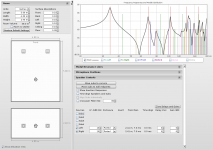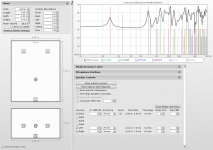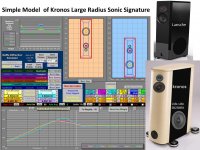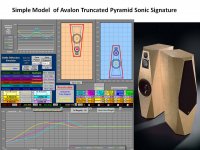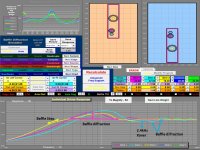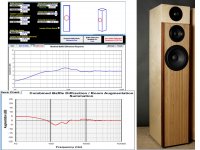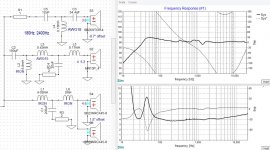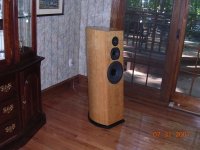What is it about the Mk2 Ektas you find attractive?
Hi, andy19191,
Thanks for contributing and sorry I'm late with reply.
You're so right about getting used to a design that might be technically or theoretically "incorrect". As I've upgraded my front end over the years I have indeed had the occasional, fleeting moment of doubt, but generally, the Es22s, are a revealing speaker and whatever their limitations, they have allowed me to hear and enjoy those changes/improvements and I've never wanted to go back. I'm pretty open to fresh perspectives.
TG, with his 25M sq. living room seems to imply that the Ekta 11 might benefit from subs and there is just a hint from LineSource and yourself that points in the same direction. Perhaps this makes me an awkward customer, but I definitely don't want to bring subs, or acoustic room treatment into the equation (we do have soft furnishings and at least a heavy rug in front of the speakers) and an active crossover solution is beyond the scope of what I feel I can achieve - so it's all down to the speakers I'm afraid, or speaker placement. I haven't heard from LineSource re placing Ektas closer to the walls behind them.
LineSource, whilst not dismissing stepped baffle designs, seems to suggest that maybe their usefulness is a touch overrated; Giralfino is deeply sceptical; you find them a crude solution and we both find them ugly! Obviously, If I thought that such designs might produce something wonderful, I'd use fine detail to try and overcome any aesthetic deficiencies - if...
As to what attracts me about the Ekta 11?
It's a complete kit and so for me it's within my range of competence. Very naive of me perhaps, but TG now refers to it as his reference point for slim, floor standing three ways and he comments on a wide and deep sound stage even at low levels There's also a lot more engaged feedback and discussion available for TG designs than there is for e.g Zaph or Selah* audio designs *(e.g. the affordable and good looking and flat baffled "Essenza") and I'm sure I'd rather go for an SBA 10 than say a three way Kairos where, visually and perhaps sonically too, that design seems to suffer from the third speaker being an afterthought.
I looked at the new TG SBA 16 MTM design, but TG says that to his ears the Ekta 11 sounds better - as one might hope for given the difference in cost. Giralfino reckons DTQWT would be O.T.T for the size of my room, so now I'm wondering, in spite of my predilection for 3 way, about the TQWT - still comes with that stepped baffle though, and at least the Ekta11 can be veneered throughout - provided I don't put a chamfered curve on that baffle, as Line Source suggests. Then there's the much more expensive SBA10....
Any thoughts and comments on my dilemma would be very much appreciated!
Paul
Hi, andy19191,
Thanks for contributing and sorry I'm late with reply.
You're so right about getting used to a design that might be technically or theoretically "incorrect". As I've upgraded my front end over the years I have indeed had the occasional, fleeting moment of doubt, but generally, the Es22s, are a revealing speaker and whatever their limitations, they have allowed me to hear and enjoy those changes/improvements and I've never wanted to go back. I'm pretty open to fresh perspectives.
TG, with his 25M sq. living room seems to imply that the Ekta 11 might benefit from subs and there is just a hint from LineSource and yourself that points in the same direction. Perhaps this makes me an awkward customer, but I definitely don't want to bring subs, or acoustic room treatment into the equation (we do have soft furnishings and at least a heavy rug in front of the speakers) and an active crossover solution is beyond the scope of what I feel I can achieve - so it's all down to the speakers I'm afraid, or speaker placement. I haven't heard from LineSource re placing Ektas closer to the walls behind them.
LineSource, whilst not dismissing stepped baffle designs, seems to suggest that maybe their usefulness is a touch overrated; Giralfino is deeply sceptical; you find them a crude solution and we both find them ugly! Obviously, If I thought that such designs might produce something wonderful, I'd use fine detail to try and overcome any aesthetic deficiencies - if...
As to what attracts me about the Ekta 11?
It's a complete kit and so for me it's within my range of competence. Very naive of me perhaps, but TG now refers to it as his reference point for slim, floor standing three ways and he comments on a wide and deep sound stage even at low levels There's also a lot more engaged feedback and discussion available for TG designs than there is for e.g Zaph or Selah* audio designs *(e.g. the affordable and good looking and flat baffled "Essenza") and I'm sure I'd rather go for an SBA 10 than say a three way Kairos where, visually and perhaps sonically too, that design seems to suffer from the third speaker being an afterthought.
I looked at the new TG SBA 16 MTM design, but TG says that to his ears the Ekta 11 sounds better - as one might hope for given the difference in cost. Giralfino reckons DTQWT would be O.T.T for the size of my room, so now I'm wondering, in spite of my predilection for 3 way, about the TQWT - still comes with that stepped baffle though, and at least the Ekta11 can be veneered throughout - provided I don't put a chamfered curve on that baffle, as Line Source suggests. Then there's the much more expensive SBA10....
Any thoughts and comments on my dilemma would be very much appreciated!
Paul
Last edited:
I forgot to add that if it's an indicator of room effects at all, the es22's in their current resting place can sometimes sound a little bright/piercing/hard in the upper treble - let's say Dylan's harmonica on the J.W.H. album, but I wouldn't want to sacrifice detail O.T.O.H all classical piano sounds heartbreakingly good and convincing right across that frequency range and finally bass has plenty of timbre and is always tuneful, but it's perhaps not always as powerful, or assertive (for assertive perhaps substitute boomy from wall reflections - who cares on a Saturday night!) as I recall it, from another time and place. I think My system sounds better with doors open and a more assertive, (or is it boomy?) bass makes an appearance, if I am well off horizontal axis, to one side of my room or the other, regardless of which speaker is doing bass. The es22's always give me a pretty thrilling sense of the particular acoustics and ambience of the recorded venue.
Last edited:
Thanks for that Paul!
Are your speakers one of his named designs, or were they custom made for you? I also wonder how you feel they compare with what you've had before? I'm out for a couple of hours, so if you do reply please bear with me. I don't have a smart phone - maybe because I spend all my spare cash on Hi Fi.
Paul
Are your speakers one of his named designs, or were they custom made for you? I also wonder how you feel they compare with what you've had before? I'm out for a couple of hours, so if you do reply please bear with me. I don't have a smart phone - maybe because I spend all my spare cash on Hi Fi.
Paul
Hi Paul,
They were a custom job, 10" sealed woofer, 5" mid, dome tweet,
I did the cabinet design and Rick did the driver measurements and crossovers. They are one of the best sounding speakers that I've heard. I've gone to HiFi shops to listen to expensive speakers and have not been impressed, except for the cabinet work, for big bucks you can get a real pretty cabinet and finish. Of course comparing an optimized home system to speakers in a store isn't really a totally fair comparison. I have heard some of Rick's commercial kits and they sounded great.
In my cabinet design the time alignment of the drivers was achieved by driver location and slanting the speaker at an angle.
They were a custom job, 10" sealed woofer, 5" mid, dome tweet,
I did the cabinet design and Rick did the driver measurements and crossovers. They are one of the best sounding speakers that I've heard. I've gone to HiFi shops to listen to expensive speakers and have not been impressed, except for the cabinet work, for big bucks you can get a real pretty cabinet and finish. Of course comparing an optimized home system to speakers in a store isn't really a totally fair comparison. I have heard some of Rick's commercial kits and they sounded great.
In my cabinet design the time alignment of the drivers was achieved by driver location and slanting the speaker at an angle.
When I first started a proper hi-fi speaker had a tweeter, midrange and a 12" woofer. The laws of physics haven't changed since then although today that proper hi-fi speaker is typically a 1" tweeter, 5" midrange and 2 x 8" woofers in a tower as reflected in the top of the range offerings from the more conservative larger speaker companies. The Ekta II has a single 6.5" midwoofer supported by resonating port tuned to 40 Hz and has insufficient area for clean bass in a room on it's own.Any thoughts and comments on my dilemma would be very much appreciated!
So why do many consider their ported 6.5" midwoofer to be sufficient? Probably because the lowest frequency room modes raise the volume of some of the bass frequencies by 20 dB or so while suppressing others by similar amounts. This boom can be loud but it isn't high fidelity bass.
If the room is going to add uneven 20 dB booms to the output of main speakers with a flat frequency response how does one get high fidelity bass? This is achieved by using distributed subwoofers to absorb/cancel booming frequencies below 100 Hz or so and directed bass and/or passive absorption above. Using subwoofers to remove sound rather than just to add to it means that plenty of cone area needs to be involved.
If you decide decent quality bass is unimportant should you go for uneven booming bass or little bass? Both can be provided by single 6.5" midwoofers. It is only high fidelity bass that cannot. Also if you opt against high fidelity bass then opting for extremely expensive drivers to cover the remaining frequencies is perhaps a bit odd.
You will notice that you are not getting wholly consistent advice and so will have to decide where to place your trust. Opting for an existing kit looks wise to me given your background. TG has been developing speakers as a hobby for quite some time and I doubt anyone can point at any of his recent designs and justify calling them technically poor. However, his enthusiasms can lead to somewhat unbalanced designs where one or two aspects are perhaps a bit too expensive and as a hobbyist he quite understandably tends to try this and that to see how they work out.
The Ekta II uses very expensive drivers but with a single 6.5" midwoofer would require subwoofers to perform as a full range speaker. The SBA 10 version without the expensive tweeter appears to be a better performing and a better value speaker although this has to be qualified by the likely room response. I am baffled by the price being asked for the cheapest version of the crossovers. Passive crossovers don't make much sense when they cost more than the drivers and I would have expected the cost of a crossover using decent standard components to be a lot less. Since the values have not been published it won't be straightforward to get decent standard parts from other sources. If you are happy to view this extra cost as a charge for the design then perhaps it is fair enough.
- Problems arising can be reduced by keeping the C. to C. as short as possible -
in the case of the Ekta, 14.5cm.
The holy grail is to keep C-C within 1/4 wavelength at the XO point — the drivers become essentially co-incidental.
dave
A proper hi fi speaker and the laws of physics
Thanks planet10 - more homework for me!
Thanks PJN - you came in at the right moment and I'll contact Rick Craig about his twin woofer designs.
Yes, respect for the laws of physics - it's a proper hi-fidelity speaker that I'm looking for!
Thank you for some rock solid advice andy19191 and for reading this thread with such meticulous sensitivity and care. I never expected wholly consistent advice - all part of the fun - and I am very, very grateful for each and every contribution.
So, I have found a way forward and it seems no coincidence that PJN's response also makes reference to a classic 10/12 x 5/6 x 1 approach for a balanced 3 way design.
On the basis of your last response, I hope I'm right in assuming that 2 x 7.5/8 woofers per speaker (re "most commercial designs") have a decent chance of achieving the same objective as a single 10/12 - obviously, I should explore this a little more. If this is the case, then I'm in a good place to weigh some of those twin woofer Selah design's (starting with the "Essenza") against the SBA 10 - interestingly, both designs use the Satori drivers.
I'm not quite sure where transmission lines stand, as far as "high fidelity bass" is concerned. In any case, the epic "Thor MTM" thread suggests to me that it might be rather a tricky path to navigate....
As regards the laws of physics and the size of woofers, I note that TG himself remarks that " ... I wish it was possible to demonstrate to all first-time diy'ers what it sounds like when we compare a 6" bass driver with -3dB @ 30 Hz to a 12" bass driver with -3 dB @ "only" 50 Hz..."
All the best,
Paul
Thanks planet10 - more homework for me!
Thanks PJN - you came in at the right moment and I'll contact Rick Craig about his twin woofer designs.
Yes, respect for the laws of physics - it's a proper hi-fidelity speaker that I'm looking for!
Thank you for some rock solid advice andy19191 and for reading this thread with such meticulous sensitivity and care. I never expected wholly consistent advice - all part of the fun - and I am very, very grateful for each and every contribution.
So, I have found a way forward and it seems no coincidence that PJN's response also makes reference to a classic 10/12 x 5/6 x 1 approach for a balanced 3 way design.
On the basis of your last response, I hope I'm right in assuming that 2 x 7.5/8 woofers per speaker (re "most commercial designs") have a decent chance of achieving the same objective as a single 10/12 - obviously, I should explore this a little more. If this is the case, then I'm in a good place to weigh some of those twin woofer Selah design's (starting with the "Essenza") against the SBA 10 - interestingly, both designs use the Satori drivers.
I'm not quite sure where transmission lines stand, as far as "high fidelity bass" is concerned. In any case, the epic "Thor MTM" thread suggests to me that it might be rather a tricky path to navigate....
As regards the laws of physics and the size of woofers, I note that TG himself remarks that " ... I wish it was possible to demonstrate to all first-time diy'ers what it sounds like when we compare a 6" bass driver with -3dB @ 30 Hz to a 12" bass driver with -3 dB @ "only" 50 Hz..."
All the best,
Paul
I'm not quite sure where transmission lines stand, as far as "high fidelity bass" is concerned. In any case, the epic "Thor MTM" thread suggests to me that it might be rather a tricky path to navigate....
As long as a proper modeler is used (and the user figures out how to use the modeller), one can get good, consistent results with a TL. Joe made the mistake of thinking he could secound guess the modeling tables, and then a bone-head mistake when measuring the built speaker’s response.
We have built a number of TLs for our WAW (formerly called FASTs) that employ TLs with quite satisfying results.
dave
In post #11 LineSource posted pictures of what looks like a nicely balanced and good value speaker (assuming sensible crossover). I don't know the details or how well documented it is?On the basis of your last response, I hope I'm right in assuming that 2 x 7.5/8 woofers per speaker (re "most commercial designs") have a decent chance of achieving the same objective as a single 10/12 - obviously, I should explore this a little more. If this is the case, then I'm in a good place to weigh some of those twin woofer Selah design's (starting with the "Essenza") against the SBA 10 - interestingly, both designs use the Satori drivers.
At low frequencies what you hear is principally the room. Unlike at higher frequencies the speaker details are relatively unimportant. Pretty much all that matters is how much air can be displaced while keeping distortion levels reasonable. Reasonable would be below 1% possibly 3% THD since we are not particularly sensitive to distortion at low frequencies.I'm not quite sure where transmission lines stand, as far as "high fidelity bass" is concerned. In any case, the epic "Thor MTM" thread suggests to me that it might be rather a tricky path to navigate....
High fidelity bass is about distributing subwoofers to control the room response. If you don't do that then you won't hear high fidelity bass. For example, a pair of main speakers with a flat frequency response down to 10 Hz in a typical room are going to sound like the plot in the first attachment. A single subwoofer placed behind the listener, inverted and delayed by the time of flight from the mains will give a response more like that in the second attachment. Of course this is not what a typical audiophile would do with a single subwoofer but it is what pro or someone with knowledge of room acoustics is likely to do. The software, Room EQ Wizard, is free to download and is useful for understanding some basic subwoofer layouts.
Attachments
Only measurements at different angles on the final speaker will produce accurate SPL curves, but simulators provide excellent information for early decisions. Diffraction simulation of different baffle designs (large edge radius; truncated pyarmid, small edge radius narrow box) help the designer select the desired sonic signature. Baffle/room simulators cover speaker placement and room gain.
Attached simulation shows in-room bass for two 8" woofers(like Sony SS-AR1). (WxHxD: 320 x 1055 x 450 mm)
The Kairos and SB10 use one 10" woofer. A 12" woofer is sometimes mounted on the side panel.
SB Acoustics 3 way
one = $366 drivers + $90 crossover
1" SB26STCN-C000-4 $40
5" Satori MR13P-4 $132
2 x 8'' SB23NRXS45-8 2x $94
==== Sd cone area ====
18" 1220 cm2
15" 855 cm2
12" 530 cm2
10" 345 cm2
8" 225 cm2
7" 180 cm2
6" 125 cm2
5" 85 cm2
Attached simulation shows in-room bass for two 8" woofers(like Sony SS-AR1). (WxHxD: 320 x 1055 x 450 mm)
The Kairos and SB10 use one 10" woofer. A 12" woofer is sometimes mounted on the side panel.
SB Acoustics 3 way
one = $366 drivers + $90 crossover
1" SB26STCN-C000-4 $40
5" Satori MR13P-4 $132
2 x 8'' SB23NRXS45-8 2x $94
==== Sd cone area ====
18" 1220 cm2
15" 855 cm2
12" 530 cm2
10" 345 cm2
8" 225 cm2
7" 180 cm2
6" 125 cm2
5" 85 cm2
Attachments
response to andy19191 and LineSource - woof woof!
Andy 19191
I'd sort of avoided the notion of a sub at all costs: partly because I didn't realise that I don't need an AV receiver to make the connection. It seems, instead, that I can simply use a sub's high level inputs to connect to the existing outputs on my amp for the es22's, duh! the other reason was a comment by someone, way back in time, to the effect that he worried his es22's transient response might be too good for a sub to keep up with ...(?) ... (!)
So thanks for gently nudging me forward. Not too clever at interpreting graphs, as I'm sure you've figured already, but I take it that thumbnail 1 = bad and thumbnail 2 = good and just to let you know that it's still me, here's a really silly question for you:
If, as you suggest (and I've heard it said before), a sub is better thought of as a means for controlling room response, can a sub do this AND act as substitute for a 10/12" single woofer (or 2 x 8" ones), or would it be better to see it as more effective when working alongside balanced 3 way 12/10 - 5/6 - 1 speakers such as the SBA 10?
Thanks for the tip re EQ room wizard - even if in the end I just use my ears - which, by now, are probably in much better nick than my brain.
LineSource and andy19191
LineSource, Thanks for making it implicitly clear that two woofs can be just as good as one. The two thumbnails with crossover schema and costed crossover/ speakers for a 'balanced' 3 way design make a powerful point about what can be achieved cost wise and sound wise when you have the know how and are not dependent on 'key in hand' solutions such as the now closed designs by TG.
Maybe I can find a friend who could help me interpret and convert it into a parts list/ actual,physical design.
In spite of your best and incredibly generous efforts, I'm in well over my head with the ball park baffle/room response graphs. I've looked hard, but I'm afraid I really don't know how to interpret and extrapolate from them. Maybe, you, or andy19191, could summarise their implications in layman's terms - especially good of you to include a graph for the Ekta 11... I hear a deep sigh from out there, somewhere ...
PS re the thumbnails in post 11, I understood these to be a general picture about the effect of different baffle designs. The DIY picture was Tony Gee's Soup Ceramique 11 and crossover design - apparently not available now, but in any case I think those Acuton drivers are pretty pricey items. Interestingly, Tony Gee appears to be the brains behind Humble Hi-fi. He seems to be leaning in the less is more aka es22/es14 direction that Robin Marshall/ Epos acoustics, Naim and others espoused some 30 years ago. I don't suppose there's a debate to be had about this now... I recall at least one raised eyebrow on this forum when Tony Gee's 'Plutone' 2 way came under review. What is it about these guys with TG as their initials?
Andy 19191
I'd sort of avoided the notion of a sub at all costs: partly because I didn't realise that I don't need an AV receiver to make the connection. It seems, instead, that I can simply use a sub's high level inputs to connect to the existing outputs on my amp for the es22's, duh! the other reason was a comment by someone, way back in time, to the effect that he worried his es22's transient response might be too good for a sub to keep up with ...(?) ... (!)
So thanks for gently nudging me forward. Not too clever at interpreting graphs, as I'm sure you've figured already, but I take it that thumbnail 1 = bad and thumbnail 2 = good and just to let you know that it's still me, here's a really silly question for you:
If, as you suggest (and I've heard it said before), a sub is better thought of as a means for controlling room response, can a sub do this AND act as substitute for a 10/12" single woofer (or 2 x 8" ones), or would it be better to see it as more effective when working alongside balanced 3 way 12/10 - 5/6 - 1 speakers such as the SBA 10?
Thanks for the tip re EQ room wizard - even if in the end I just use my ears - which, by now, are probably in much better nick than my brain.
LineSource and andy19191
LineSource, Thanks for making it implicitly clear that two woofs can be just as good as one. The two thumbnails with crossover schema and costed crossover/ speakers for a 'balanced' 3 way design make a powerful point about what can be achieved cost wise and sound wise when you have the know how and are not dependent on 'key in hand' solutions such as the now closed designs by TG.
Maybe I can find a friend who could help me interpret and convert it into a parts list/ actual,physical design.
In spite of your best and incredibly generous efforts, I'm in well over my head with the ball park baffle/room response graphs. I've looked hard, but I'm afraid I really don't know how to interpret and extrapolate from them. Maybe, you, or andy19191, could summarise their implications in layman's terms - especially good of you to include a graph for the Ekta 11... I hear a deep sigh from out there, somewhere ...
PS re the thumbnails in post 11, I understood these to be a general picture about the effect of different baffle designs. The DIY picture was Tony Gee's Soup Ceramique 11 and crossover design - apparently not available now, but in any case I think those Acuton drivers are pretty pricey items. Interestingly, Tony Gee appears to be the brains behind Humble Hi-fi. He seems to be leaning in the less is more aka es22/es14 direction that Robin Marshall/ Epos acoustics, Naim and others espoused some 30 years ago. I don't suppose there's a debate to be had about this now... I recall at least one raised eyebrow on this forum when Tony Gee's 'Plutone' 2 way came under review. What is it about these guys with TG as their initials?
Hi Paul,
This is an example of a sloped baffle for time alignment, in this case due to driver placement the slope is about 8 degrees from vertical to give good alignment at the listening position. This is also taken into consideration in the crossover design. The woofer position was determined by in room measurements that gave the smoothest response in the room these were intended for, then the mid/tweet were mounted as close as possible. The slope was determined by doing the math from the design listening distance (~ 16-18 ft) to the acoustic centers of the drivers. Simple trig, built a spreadsheet model and adjusted the angle to yield the minimum difference between the distances between the acoustic centers and the design listening spot. The wider baffle for the tweeter and mid did seem to give things a more spacious feeling compared to narrow baffles that I've heard/built. Later I fitted the baffle area around the tweet/mid with felt with the idea to reduce diffraction. I'm not sure if it did much, but it made me feel better. No sub needed. If you can build your own cabinets you have a lot of freedom with design.
Paul
This is an example of a sloped baffle for time alignment, in this case due to driver placement the slope is about 8 degrees from vertical to give good alignment at the listening position. This is also taken into consideration in the crossover design. The woofer position was determined by in room measurements that gave the smoothest response in the room these were intended for, then the mid/tweet were mounted as close as possible. The slope was determined by doing the math from the design listening distance (~ 16-18 ft) to the acoustic centers of the drivers. Simple trig, built a spreadsheet model and adjusted the angle to yield the minimum difference between the distances between the acoustic centers and the design listening spot. The wider baffle for the tweeter and mid did seem to give things a more spacious feeling compared to narrow baffles that I've heard/built. Later I fitted the baffle area around the tweet/mid with felt with the idea to reduce diffraction. I'm not sure if it did much, but it made me feel better. No sub needed. If you can build your own cabinets you have a lot of freedom with design.
Paul
Attachments
PJN's room based design
Hi Paul,
Wow, beautiful speakers and certainly what I would aspire to for a 3 way design as far as looks are concerned! Your comments provoke some key questions for me that seem to me to be in lockstep with this thread.
I'm assuming that the in room measurement work was done with a room simulator program of the kind that andy19191 refers to in post 30?
How much freedom to design own cabinet? I get it that room measurements come first, but then what about issues re volume, the nature of each driver's enclosure, the positioning of bracing and of vent where appropriate. Who or what determines these? Was Rick Craig involved in this aspect of the design, or just in the specification of the crossovers and speakers once you had decided on the cabinet's form? Which is the very first step with those cabinets e.g. an informed guess at dimensions with pure aesthetics as the initial guide?
A lot of quite naive questions I know, but I would love to have just a simple outline idea of the sequence of your project and what it entailed.
I'm particularly interested in your comment about no need for a sub. TG has said this about some of his designs but as far as I can see, he never explained why!
All the best and thanks for this intriguing post,
Paul
Hi Paul,
Wow, beautiful speakers and certainly what I would aspire to for a 3 way design as far as looks are concerned! Your comments provoke some key questions for me that seem to me to be in lockstep with this thread.
I'm assuming that the in room measurement work was done with a room simulator program of the kind that andy19191 refers to in post 30?
How much freedom to design own cabinet? I get it that room measurements come first, but then what about issues re volume, the nature of each driver's enclosure, the positioning of bracing and of vent where appropriate. Who or what determines these? Was Rick Craig involved in this aspect of the design, or just in the specification of the crossovers and speakers once you had decided on the cabinet's form? Which is the very first step with those cabinets e.g. an informed guess at dimensions with pure aesthetics as the initial guide?
A lot of quite naive questions I know, but I would love to have just a simple outline idea of the sequence of your project and what it entailed.
I'm particularly interested in your comment about no need for a sub. TG has said this about some of his designs but as far as I can see, he never explained why!
All the best and thanks for this intriguing post,
Paul
Hi Paul,
The first step is setting your goal, mine was a 3 way floor stander with adequate bass response that would fit my room decor. Next step is driver selection, best bang for what you can afford, at the time I liked some of the offerings by Peerless and chose them. Once the drivers have been selected you run some box simulations to get an idea of the cabinet dimensions. In this case I had been speaking with Rick ahead of time about my project and about doing the crossovers for me. Rick had worked with this model woofer before and recommended a sealed alignment so that is what I modeled it for. I could have went with a ported design also, but with room gain and a recommendation I went with sealed. Once the cabinet dimensions are understood, move on to the styling piece that can fit with the constraints of the cabinets size and room. I had an idea of the volumes to make the drivers happy, I used a spl meter and a test CD to get in room responses for the woofer placement relative to the floor. I found that the placement above the floor did affect response (floor bounce, ect) so I settled on a height that gave me the smoothest in room response up to ~ 500 hz, after that I didn't much care since the woofer would be rolled off in the crossover. Once the woofer height was set I finalized the cabinet design and styling. Then I sent the drivers to Rick with a copy of my intended cabinet design. He has much better measuring tools and experience than me, and did far field as well as near field measurements of the drivers mounted on a baffle. He then completed the crossover design and returned my drivers. After which I built the cabinets and crossovers and assembled things. As for the subwoofer thing, some people love big powerful bass, it might not be natural, but who are we to tell them what to like. I listen to a lot of live music and like a natural, realistic response, the lower registers on a base should sound close to what you hear at the concert, not liquefy your bowels. Because of room gain a speaker can give better base response that a simple box model predicts. There are some free excel based models that will allow you to model room gain to get a feel for it. So in my room (14' X 28' x 8') with 10" woofers I feel get more than adequate base with response down into the high 20's. If you go with a pre-engineered kit the designer has already went through all of these steps for you, so you just buy the kit and build the cabinets according to the supplied plan. By the way, building the cabinets is the hardest part, and can get pricey, but it is satisfying when you're done.
Paul
The first step is setting your goal, mine was a 3 way floor stander with adequate bass response that would fit my room decor. Next step is driver selection, best bang for what you can afford, at the time I liked some of the offerings by Peerless and chose them. Once the drivers have been selected you run some box simulations to get an idea of the cabinet dimensions. In this case I had been speaking with Rick ahead of time about my project and about doing the crossovers for me. Rick had worked with this model woofer before and recommended a sealed alignment so that is what I modeled it for. I could have went with a ported design also, but with room gain and a recommendation I went with sealed. Once the cabinet dimensions are understood, move on to the styling piece that can fit with the constraints of the cabinets size and room. I had an idea of the volumes to make the drivers happy, I used a spl meter and a test CD to get in room responses for the woofer placement relative to the floor. I found that the placement above the floor did affect response (floor bounce, ect) so I settled on a height that gave me the smoothest in room response up to ~ 500 hz, after that I didn't much care since the woofer would be rolled off in the crossover. Once the woofer height was set I finalized the cabinet design and styling. Then I sent the drivers to Rick with a copy of my intended cabinet design. He has much better measuring tools and experience than me, and did far field as well as near field measurements of the drivers mounted on a baffle. He then completed the crossover design and returned my drivers. After which I built the cabinets and crossovers and assembled things. As for the subwoofer thing, some people love big powerful bass, it might not be natural, but who are we to tell them what to like. I listen to a lot of live music and like a natural, realistic response, the lower registers on a base should sound close to what you hear at the concert, not liquefy your bowels. Because of room gain a speaker can give better base response that a simple box model predicts. There are some free excel based models that will allow you to model room gain to get a feel for it. So in my room (14' X 28' x 8') with 10" woofers I feel get more than adequate base with response down into the high 20's. If you go with a pre-engineered kit the designer has already went through all of these steps for you, so you just buy the kit and build the cabinets according to the supplied plan. By the way, building the cabinets is the hardest part, and can get pricey, but it is satisfying when you're done.
Paul
Hi Paul,
This is very clear and helpful and interesting - plenty for me to explore over the next day or so, Meanwhile:
So the test measurements were done with just the bare woofer hooked up? Which test CD?
I can see that the use of a single 10/12" driver might have an advantage over 2 woofers
in terms of height from floor - something that concerned me about Rick's "Essenza".
I'm with you on bass and bowels and being close to the original event, be that concert hall or studio!
Great post which converges very nicely with LineSource and andy19191 comments.
Paul
This is very clear and helpful and interesting - plenty for me to explore over the next day or so, Meanwhile:
So the test measurements were done with just the bare woofer hooked up? Which test CD?
I can see that the use of a single 10/12" driver might have an advantage over 2 woofers
in terms of height from floor - something that concerned me about Rick's "Essenza".
I'm with you on bass and bowels and being close to the original event, be that concert hall or studio!
Great post which converges very nicely with LineSource and andy19191 comments.
Paul
Hi Paul,
I used the just 10" woofer in a sealed box, close to the volume of the final design. good enough to get a feel for in room response for the bass area. I didn't care about anything else because the actual response of the drivers and the final response would be measured and taken care of in the crossover design phase. The test CD was just frequency sweeps, 20 HZ, 30 Hz, 40 HZ .....500 HZ.
Two woofers can have the advantage over one woofer in some designs, for example two 8" woofers have a displacement greater than one 10" (450 cm2 vs 345 cm2) and can provide lower distortion (higher SD don't need to move as much), might be able to cross higher if needed for the midrange choice, and have higher efficiency depending on the design. Two 8" woofers can give just as low bass as bigger woofers, and there are a lot of nice 8" woofers available on the market. They can also provide a slimmer cabinet which is a look that a lot of people like. Of course the downside is that you need to buy two more woofers, but in the grand scheme of things that's not a big deal. If you have any questions/concerns about a designers choices you ought to be able to contact them for clarification. In Rick's case he has a blog/forum on his website, he knows better than me about the trade offs between many vs single woofers.
Paul
I used the just 10" woofer in a sealed box, close to the volume of the final design. good enough to get a feel for in room response for the bass area. I didn't care about anything else because the actual response of the drivers and the final response would be measured and taken care of in the crossover design phase. The test CD was just frequency sweeps, 20 HZ, 30 Hz, 40 HZ .....500 HZ.
Two woofers can have the advantage over one woofer in some designs, for example two 8" woofers have a displacement greater than one 10" (450 cm2 vs 345 cm2) and can provide lower distortion (higher SD don't need to move as much), might be able to cross higher if needed for the midrange choice, and have higher efficiency depending on the design. Two 8" woofers can give just as low bass as bigger woofers, and there are a lot of nice 8" woofers available on the market. They can also provide a slimmer cabinet which is a look that a lot of people like. Of course the downside is that you need to buy two more woofers, but in the grand scheme of things that's not a big deal. If you have any questions/concerns about a designers choices you ought to be able to contact them for clarification. In Rick's case he has a blog/forum on his website, he knows better than me about the trade offs between many vs single woofers.
Paul
the other reason was a comment by someone, way back in time, to the effect that he worried his es22's transient response might be too good for a sub to keep up with ...(?) ... (!)
Did he also talk about "fast bass"? What you hear at low frequencies is mainly the room resonances and these tend to build up loud and resonate for a long time. The brain can separate source and room by processing direct and indirect sound differently but this tends to happen for frequencies above those handled by subwoofers.
The lowest frequencies the ES22 can produce will be boosted by the box/port resonance but at these frequencies a typical subwoofer will not be boosting its output with its own box/port resonance which will be at a lower frequency. This means that over the frequency range the ES22 and the sub overlap, the sub cone will follow the input signal better than the ES22.
There is more to it than that. The plot illustrates how a sub can absorb axial room resonances but there are other considerations. If you cancel a lot of sound to get an even response then that even response is going to be quiet. So you need a lot of cone area so that the sound that isn't cancelled is loud enough. It also uses symmetry to cancel some of the modes but real rooms are often not symmetric requiring subwoofers in more than one place. So in the real world good implementation tend to use perhaps 4 subwoofers and some DSP so that the subs can act differently at different frequencies.So thanks for gently nudging me forward. Not too clever at interpreting graphs, as I'm sure you've figured already, but I take it that thumbnail 1 = bad and thumbnail 2 = good
Struggling to interpret graphs will cripple your ability to gather evidence and lead you to being blown this way and that by marketing and nonsense.
It doesn't matter much whether the main speakers are satellites or full range if they are adequately sized. A pair of subs close to satellite mains is a bit more flexible but full range mains generally won't short change clean SPL around the crossover region which small bookshelf speakers as mains likely will.If, as you suggest (and I've heard it said before), a sub is better thought of as a means for controlling room response, can a sub do this AND act as substitute for a 10/12" single woofer (or 2 x 8" ones), or would it be better to see it as more effective when working alongside balanced 3 way 12/10 - 5/6 - 1 speakers such as the SBA 10?
- Status
- This old topic is closed. If you want to reopen this topic, contact a moderator using the "Report Post" button.
- Home
- Loudspeakers
- Multi-Way
- Ekta Mk2? Beyond the Epos ES 22s
